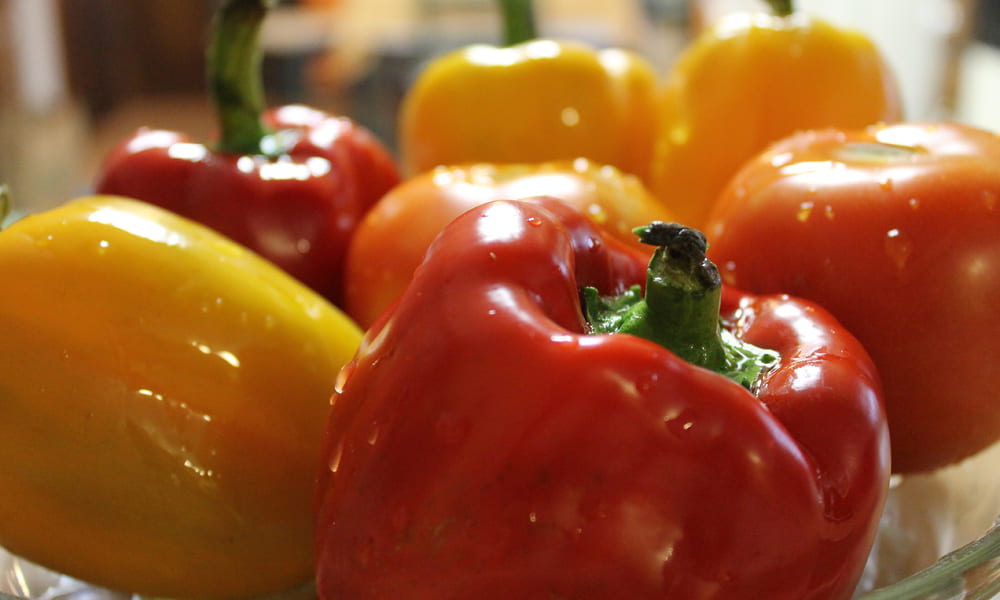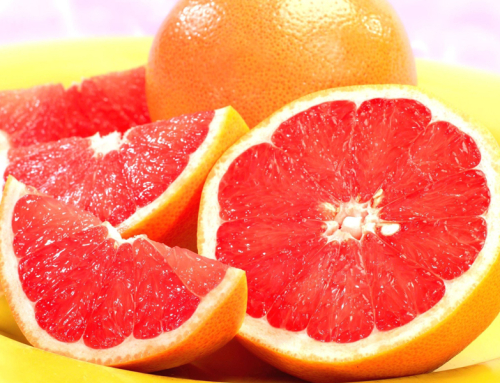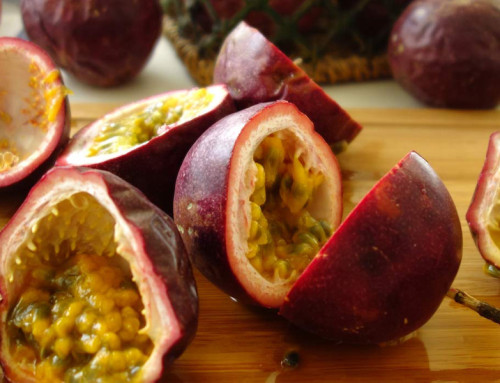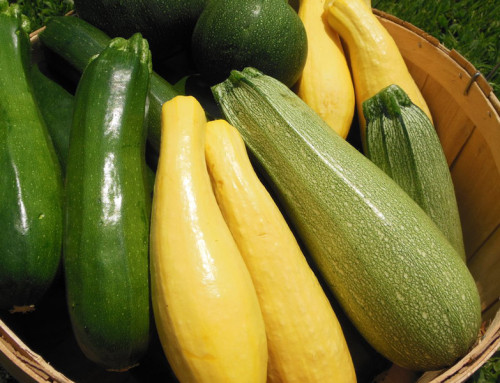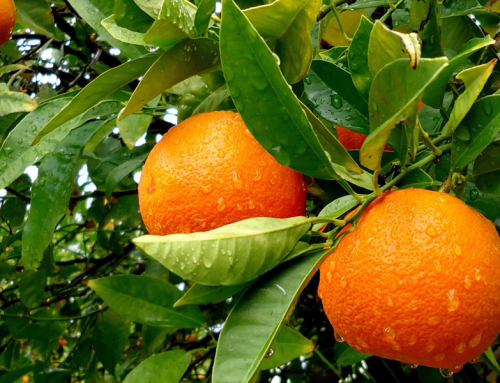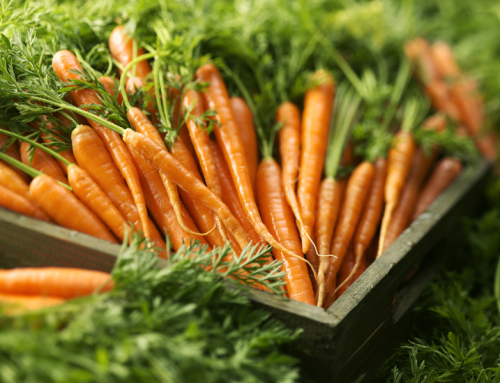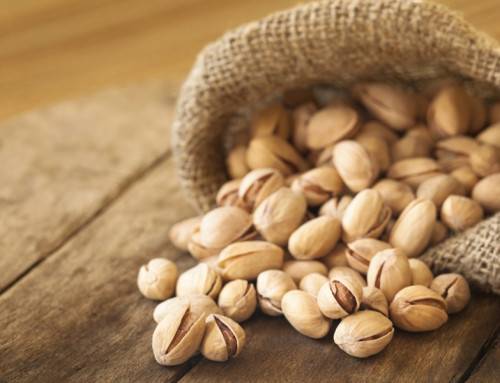- Hot chili, raw, green or red, 1 pepper (approx. 45 g) – 18 calories
- Sweet, whole (2 3/4″ long and 2 1/2″ in diameter), raw, red or green, 1 pepper (approx. 119 g) – 32 calories
- Sweet, chopped, 1 cup (approx. 149 g), raw, red or green – 40 calories
- Sweet, 1 ring 1/4″ thick (approx. 10 g), raw, red or green – 3 calories
- Sweet, 1 cup (approx. 136 g), cooked, drained and chopped, red or green – 38 calories
- Red Bell peppers are an excellent source of vitamin C, vitamin A, and vitamin B6 as well as a very good source of vitamin E and folate, and a good source of vitamin K, and potassium.
- Red Bell peppers are a rich source of antioxidants, such as lycopene, which is also found in tomatoes.
- Green Bell peppers are an outstanding source of vitamin C (one serving provides at least the daily requirement), a very good source of vitamin B6 and vitamin K, and a good source of manganese.
- Green Bell peppers are also a good source of antioxidants which may help protect our cells from damage.
- The orange “hothouse” variety of sweet bell pepper boast a Vitamin C level of 317% of the RDA,while its iron content is clocked at 22%.
- Red Bell peppers have higher concentrations of many nutrients than other Bell peppers.
- Bell peppers are an excellent source of vitamin C with 117 mg per cup. This is more than twice the amount of vitamin C found in a standard orange.
- Bell peppers are a good source of Vitamin E, an antioxidant.
- Bell peppers are also a good source of manganese, an antioxidant mineral.
- Bell peppers contain the following flavonoids: luteolin, quercetin; and hesperidin.
- Bell peppers contain the following carotenoids:alpha-carotene, beta-carotene, cryptoxanthin, lutein, and zeaxanthin.
- One cup of freshly sliced red bell pepper, contains about 1,500 mcg of beta-carotene, or the equivalent amount found in 1/3 of a small carrot.
- One cup of sliced green bell pepper contains 314 mcg (combined) of the carotenoids lutein and zeaxanthin which are found in high concentrations in the macula of the eye (the center-most part of the retina), and are required for the protection of the macula from oxygen-related damage. Age-related macular degeneration, or AMD is the leading cause of blindness in adults over the age of 60. Bell peppers can reduce the risk of AMD by a sizable amount.
- Bell peppers contain the following hydroxycinnamic Acids: ferulic acid and cinnamic acid.
- While bell peppers are not high in either protein or in the amino acid cysteine, it may be unusual in its metabolism of this amino acid. The presence of enzymes in bell peppers called cysteine S-conjugate beta-lyases may be involved in and serve as the basis for some of the anti-cancer benefits shown by green, yellow, red and orange vegetable intake and a risk reduction for gastric and esophageal cancers.
- Purple bell peppers and chocolate bell peppers are your best choice for strong antioxidant activity due to the anthocyanin flavonoid pigments.
So, what are peppers?
Green peppers, also known as bell peppers or sweet peppers, are beautifully bell-shaped fruits (not vegetables) with either three or four lobes, and with a glossy, wax-like exterior that comes in a rainbow of vivid colors. They can be green, red, yellow, orange, purple, purple-striped, brown, black and even white. The green varieties have a slightly bitter taste, while the other, rather dramatic, colors are generally much sweeter with an almost fruity flavor. However, they all are from the same plant, Capsicum annuum. which belongs to the nightshade (Solanaceae) family of plants, along with chili pepper, cayenne pepper, eggplant, tomatoes, (all of which are fruits, not vegetables) and potatoes, which is a root vegetable.
This name is also used to refer to wax peppers, cayenne peppers, chili peppers, and jalapeno peppers, which can create a bit of confusion, but they are all simply “cultivars” of the same plant, not different species.
Sweet bell peppers can be grown nearly any climate and as such, are popular around the world, even in home gardens. China is the largest producer of bell peppers, and in 2007 produced 14 million metric tons. Mexico is the second largest producer at about 2 million metric tons, with the United States in third place with approximately 1 million metric tons from California and Florida.
But no matter where they come from, the green bell peppers that you find in the produce department are not required to be labeled to tell you what you are truly getting. They may actually be immature, non-ripe versions of any of the other color varieties.
How is that possible?
Most of the bell pepper cultivars start out producing green fruit that is harvested before maturing along their full color spectrum. This is because it takes longer for the other colors to ripen and growers want their profits sooner. This is why the other colors often have a higher price.
Additionally, when peppers are picked while still green, the seeds have not matured enough to reproduce, so the main plant keeps producing more fruit. When the fruit is allowed to stay on the bush until ripening to another color, this signals the plant that additional fruit is not needed, which leads to a lower yield per plant.
A foliar spray with a compound known as ethephon may be used to speed up early ripening and color shifting, and may also be used on partially ripe fruit at the end of the growing season.
However, not all bell peppers start off green, nor do green bell peppers always mature into other colors. And, of course, to confuse matters, most green bell peppers will turn red, but they may be optimally ripe in one color before shifting to another color.
Only time will tell, but don’t wait too long to find out because there is a delicate balance regarding ripeness at the time of purchase. If a bell pepper is ripe, it can lose up to 15% of its vitamin C over a 10-day period in the refrigerator and up to 25% of vitamin C over 20-days of refrigerated storage. However, if they are not ripe, the vitamin C and carotenoids will actually increase with refrigerated storage over the next 10 days. As you can see, they can be stored for fairly long periods of time, but their vitamin C may change in the wrong direction if you wait too long before eating them.
Fortunately, bell peppers can be eaten at any stage of development so you can have any color you wish in your salad, or on your pizza and, of course, they tend to have more flavor when they are optimally ripe, assuming you can figure out when that actually is. There is no hard and fast rule for determining ripeness from the outside other than just texture, firmness and a well-hydrated weight. Inside, you may be able to tell by the maturity of the seeds, but grocers frown on cutting into peppers while still standing in the produce department.
A few of the other colors of the bell pepper rainbow:
The purple sweet bell peppers run the gamut of both colors and healthful goodness simply because they are darker than the other peppers. They contain anthocyanin pigments which are a type of flavonoid antioxidant that appears only in dark red, blue and purple fruits and vegetables. It is believed to be a cancer-fighter and also responsible for protection from developing coronary heart disease. Blueberries and red wine are most notable in these effects. The deeper the color, the greater the possible health benefits of the dietary antioxidants within the peppers, which are already fantastic to begin with.
For peppers that turn purple on the plant, it is an intermediate phase between green and red, lasting only about seven to 10 days. Here are some of the most notable “purple peppers” and their color phases:
- “Lorelei,” “Purple Belle” and “Violetta” are small bell peppers that start green, shift to purple and then to a final red. “Secret” and “Islander” are larger and do the same.
- “Tequila” starts out as a yellow pepper, changes to purple,and then turns red at full ripeness.
- “Purple Beauty” is the most widely grown of the purple peppers and is ready to eat when the fruit turns dark purple or almost black, while retaining a green undertone.
- “Merlot” peppers start out as green, shift to white, and then develop purple stripes that eventually merge to cover the whole fruit. The flesh inside is lime green.
- Chocolate bell peppers are considered to be purple peppers by growers, but “Sweet Chocolate,” is a medium-sized chocolate-brown pepper with a flesh that is cola-red inside.
- Blue bell peppers are mysteries because there are vague references to them, but not enough information given to know if they actually exist, and they may turn out to be purple.

